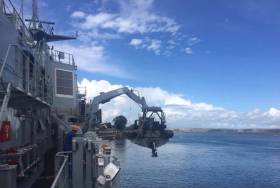Displaying items by tag: OPV90
Naval Service's Latest P60 Class Newbuild George Bernard Shaw On Sea-Trials in Bristol Channel
#NavalService - Afloat has tracked the Irish Naval Service's latest offshore patrol vessel carry out sea-trials which involved the €67m newbuild in the Bristol Channel while off the north Devon coast from where the ship was built, writes Jehan Ashmore.
The newbuild George Bernard Shaw is the fourth sister of the P60 class built in the UK yard of Babcock Marine & Technology in Appledore from where the OPV90 ship yesterday evening departed for sea-trials. The shipyard (see previous report) is located close to Bideford on the River Torridge. The facility is also where a previous generation belonging to a pair of P50 class were completed. These smaller OPV80 sisters (the figure referring to the hull length) were built at the same site of the Babcock shipyard albeit then run by Appledore Shipbuilders.
The sea-trial saw the 23-knot capable P60 newbuild head as far west offshore of Hartland Point and later to the east but approach much closer to the shore off Illfracombe. Following these manouveres the 90m newbuild headed further west involving a figure of eight loop when off Lundy Island, before returning to the Bristol Channel.
At 2,250 tonnes the P60 class newbuild, likewise of sisters form the largest in tonnage terms in the navel fleet. The newbuild comes equipped with a comprehensive command, control and communications package while the main weapon consists of a 76mm bow-mounted gun. Installation of the gun as previously reported will be fitted later this year at the Irish Naval Service base located in Cork Harbour.
As for a delivery date to the Naval Service, this is subject to the completion of successful sea trails before a voyage can be made to the Naval Base on Haulbowline Island opposite Cobh.
The OPV by then in Irish waters will be formally named 'L.E. George Bernard Shaw' and commissioned into the Irish Naval Service.





























































